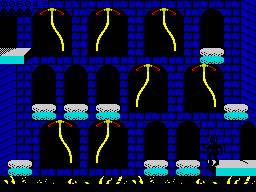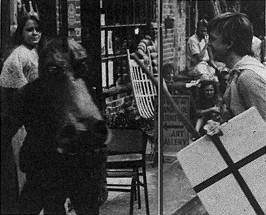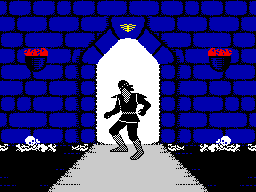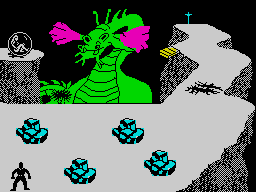
Level three, and Dirk the Daring has to get to the top of the three-tiered building.
Accompanied by garrulous ZZAP! dynamo, Julian Rignall, CRASH novice Tony Flanagan zoomed up the M6 to the land of Brookside, Bleasdale and the Beatles to get a sneak preview of Software Projects’ latest game: Dragon’s Lair.

Level three, and Dirk the Daring has to get to the top of the three-tiered building.
Perhaps it’s because of their Irish forefathers that scousers like telling jokes. Take this one, for example. Er — what d’you call a Liverpudlian in a suit? I don’t know, what do you call a Liverpudlian in a suit? The accused. “People have a sense of humour in Liverpool that makes life quite bearable,” explained Alan Maton, director of Software Projects, as we ate our lunch in the concrete garden of the Elephant and Castle. Not that Liverpool is a city of doom and gloom, though sometimes it might appear that way to us ‘southerners’ from leafy towns such as Ludlow. There is something irrepressible about Liverpool and its people that is very infectious. And what is true of Liverpool is also true of Software Projects.
The company began life in 1983 and is most widely known for two very successful games, Manic Miner and Jet Set Willy. The latter, remarked Paul Patterson, the Sales Manager, “is probably the biggest seller of all time.” How did they account for this success? “The thing about Jet Set Willy and Manic Miner,” Alan pointed out, “was that they were different from what everyone else was doing at that time.” But, like many other companies, Software Projects has not had a resounding success with every game. Jet Set Willy II, in particular, was very badly received by the computer games press.
Since October 1985, the company has adopted a new policy which puts quality as its main priority. Before then, Software Projects had produced about ten games which, as Paul remarked, “didn’t do very well and weren’t very good.” The new policy is only to market very good games — anything of dubious quality is scratched, even if a lot of money has been invested. But how do they decide what is worth marketing?
The simple answer is, they don’t — well, not all by themselves. Recently, Software Projects advertised in their local paper of players to come in and test their games ‘in progress’. The players’ comments are taken very seriously and usually acted upon. This was also the case with Dragon’s Lair, as Paul explained. “We brought in people to try Dragon’s Lair about eight weeks ago. If the response to the game had been negative, like some of the previous ones, it would have been scrapped.” Fortunately, this was not the case.
“Everyone gave the game nine or ten out of ten,” said Paul happily. “They asked us to change certain things and we did. Everything they asked us to change, we changed.” Dirk, the dynamic hero of the game, was thought to have too big a nose, so slices of it were lopped off in a neat bit of computer surgery. Some thought the first screen was too easy, so that was made more tricky. And there have been several other minor changes, all as a result of players’ suggestions.

Dragon slaying Ludlow style, a candid snap from a street performance a few weeks ago during the Festival.
So how did Alan get hold of the right to the game which is fairly well established in the arcades? The story is involved, to say the least. “I went away to Paris for a long weekend and, er, ... it was shut. I think there must have been a Bank Holiday. On the last day I went into this computer shop and there, in a box, was Dragon’s Lair for the Coleco Adam.” Alan liked the look of the game, bought it and took it home to Liverpool.
Obtaining the rights was a tortuous business. Initially, he contacted Coleco which, when he finally got hold of the right fellah, gave him the go-ahead. Unfortunately, Coleco had the rights to home computers, they didn’t have the rights to make sub deals with the licence. These rights belonged to Magicom who, as fortune would have it, had recently gone bankrupt. Eventually, Alan managed to get through to Magicom’s solicitors who agreed to license the game but explained, as Alan already knew, that the rights to home computers were owned by Coleco. As Alan put it, it was like “Er — can I go out Dad?” “Ask yer Mum.” “Er — can I go out Mum?” “Ask yer Dad.”
Eventually, the matter was resolved and Alan put together what he called a ‘Liverpool contract’. Basically, this amounted to “giz it and I’ll pay yer,” though after several amendments the contract ran to twelve pages and took five-and-a-half months to be processed through the courts. As this was only a formality, Software Projects began the programming schedule almost at once.
The progress of the programming has not been without its snags. Jim Damell, one of the programmers, outlined the initial problem. “First of all we looked at the game and decided it couldn’t be done in 64K on the Commodore — not to do it justice anyway. Then I said to The Boss that I thought the game could run while the tape was loading. It’s all based on the fact that you can play one level. By the time you’ve finished that, another level will have loaded off tape into memory.” Unfortunately, unlike the Commodore, the Spectrum version will not have that cunning load while you play facility...
The schedule took a major knock when one of the programmers decided to leave, with only two-thirds of the program done! Alan was not impressed. However, curbing any nefarious tendencies he might have had, he phoned up Andy Walker who agreed to help the company through the final phase of the schedule.
Programming the game has been a real team effort. Jim Darnell, Michael Davies, Steve Birtles, Colin Porch, Sue Maton, Nicole Baikaloff, as well as Andy Walker, have all played their part to produce a game which they hope will emulate the success of Jet Set Willy. Dragon’s Lair is now virtually finished. “We’ve got to the point where the programmers are just tidying everything up,” said Alan. It should be in the shops by the middle of August, and stores will be sent demo versions for public display.

Good old Dirk enters another corridor of doom
So what’s the game all about? Basically, Dragon’s Lair is a cross between an Arthurian romance and George and the Dragon. In it, the heroic knight Dirk the Daring is called upon to rescue King Aethelred’s daughter, Princess Daphne, from the fiery breath of Singe the evil Dragon. If the King does not renounce his Kingdom then she will die!
The game has nine screens which, as you progress, become increasingly more perilous. By means of the Falling Disk, you descend into the dungeons of the Castle and progress to the Skull Hallway, haunted by a host of osseous (LMLWD) ghosts and ghoulies. From there, by means of the Swinging Ropes which hang above a steadily ascending fire, you get to Singe’s Weapons Room, where the weaponry assumes an insidious life of its own. Next, a series of Ramps has to be negotiated — dally too long, and they disappear from under you. At the same time Giddy Goons, gargoyle-like monsters who don’t exactly have your best interests at heart have to be fought off.
Past the Ramps and rampant GGs is the Tentacle Room: Singe’s laboratory, where strange hybrids of the creepie-crawlie kind lurk, waiting to enter combat. Once the insectoid nasties have been despatched, hacked carapace from thorax, a ride on the Second Disk takes you to the penultimate level where the Phantom Knight awaits. “This eighth screen,” said Paul, “is a game in itself” in that it requires strategic thinking as well as physical dexterity. Finally, if you’re incredibly brave and mega-skilful, you reach the Dragon’s Lair and get the chance to slay the monster and free the beautiful (and voluptuous!) Princess.
The next Software Projects venture, which should be completed by the end of July, is John Silver’s Return to Treasure Island and coincides with the TV series of the same name. “The idea behind it,” Alan explained, “is to write a game which is based very loosely on Treasure Island, using the same locations and same characters but with a totally different story. You can write a program like this and get away with quite a lot of differences because you don’t have to stick to the book. People play the adventure but they don’t know what’s going to happen next.”
You play the part of Jim Hawkins and the idea is to find the Island’s hidden treasure. The Island is reproduced in 3D and is based on the original Treasure Island maps. “It works on a landscaping technique,” said Alan, which means that it draws your locations as you go along according to your position. There are, therefore, an incredible 1.5 million possible views all in full perspective.

The final screen: Dirk meets Singe, the Dragon with pink ears. Daphne waits in the bubble, but will Dirk get to the sword he needs to slay the dastardly Singe?
According to Alan, success is simply a matter of having “a bit of nowse, a bit of time and a thorough knowledge of the market.” But success certainly hasn’t gone to their heads, though both Julian and I enjoyed the trip in Alan’s Porsche — a first for us both! But if success hasn’t gone to their heads, grey hair certainly has. As Paul complained, “when I came here my hair was curly and black, now it’s straight and grey.”
As the car coughed and spluttered its way back to Ludlow, I wondered whether grey hair was contagious, and whether one day I myself would own a Porsche. Alas, some things I fear weren’t meant to be. Then I thought of one of Alan’s jokes which cheered me up a little. “What d’you call a Liverpudlian in a detached house? ... A burglar.” That would keep me going for a while.